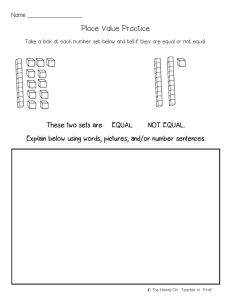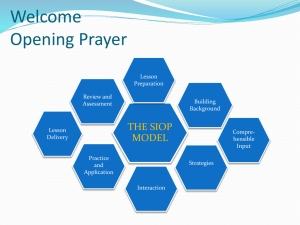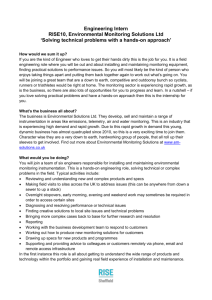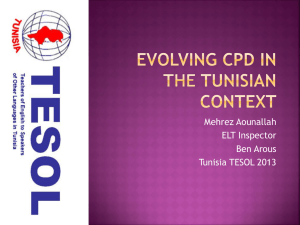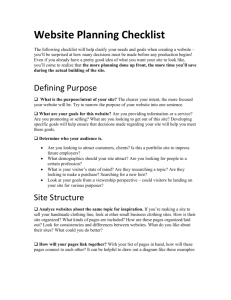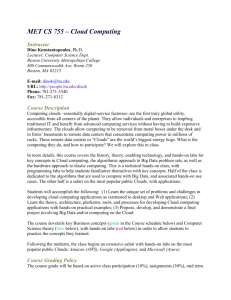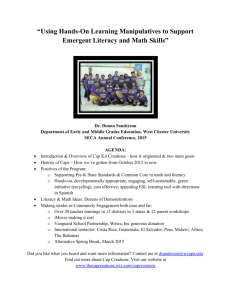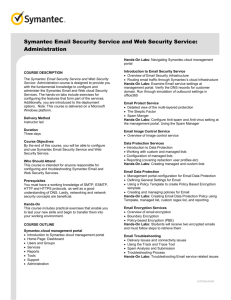LP130: Gathering and Documenting User Requirements
advertisement
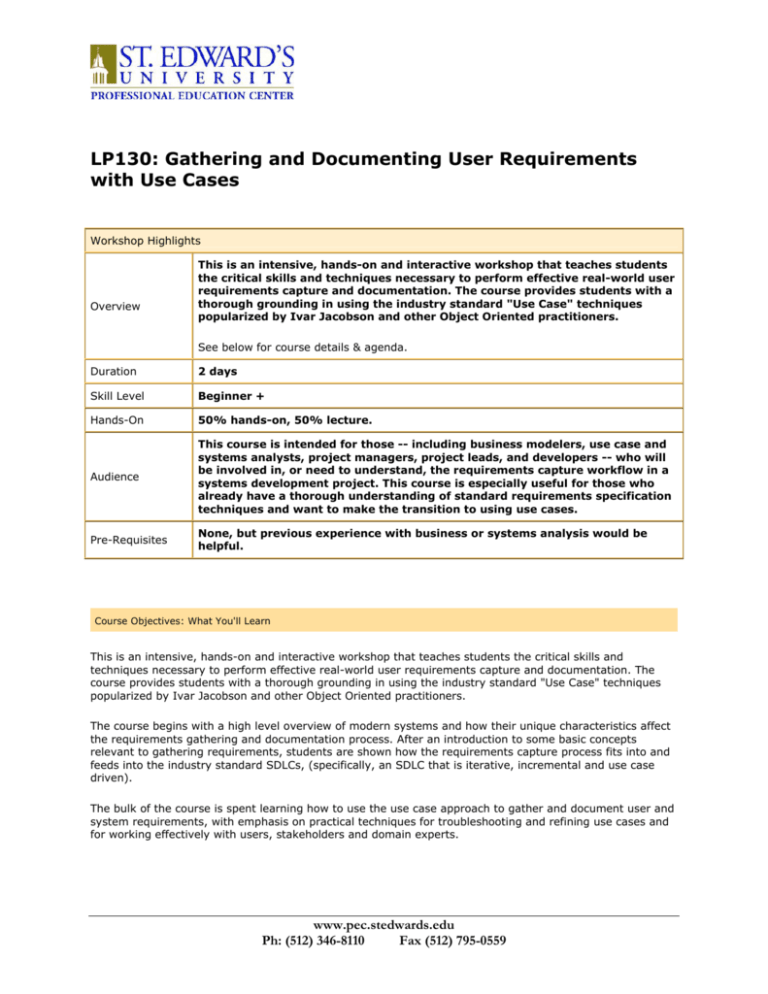
LP130: Gathering and Documenting User Requirements with Use Cases Workshop Highlights Overview This is an intensive, hands-on and interactive workshop that teaches students the critical skills and techniques necessary to perform effective real-world user requirements capture and documentation. The course provides students with a thorough grounding in using the industry standard "Use Case" techniques popularized by Ivar Jacobson and other Object Oriented practitioners. See below for course details & agenda. Duration 2 days Skill Level Beginner + Hands-On 50% hands-on, 50% lecture. Audience This course is intended for those -- including business modelers, use case and systems analysts, project managers, project leads, and developers -- who will be involved in, or need to understand, the requirements capture workflow in a systems development project. This course is especially useful for those who already have a thorough understanding of standard requirements specification techniques and want to make the transition to using use cases. Pre-Requisites None, but previous experience with business or systems analysis would be helpful. Course Objectives: What You'll Learn This is an intensive, hands-on and interactive workshop that teaches students the critical skills and techniques necessary to perform effective real-world user requirements capture and documentation. The course provides students with a thorough grounding in using the industry standard "Use Case" techniques popularized by Ivar Jacobson and other Object Oriented practitioners. The course begins with a high level overview of modern systems and how their unique characteristics affect the requirements gathering and documentation process. After an introduction to some basic concepts relevant to gathering requirements, students are shown how the requirements capture process fits into and feeds into the industry standard SDLCs, (specifically, an SDLC that is iterative, incremental and use case driven). The bulk of the course is spent learning how to use the use case approach to gather and document user and system requirements, with emphasis on practical techniques for troubleshooting and refining use cases and for working effectively with users, stakeholders and domain experts. www.pec.stedwards.edu Ph: (512) 346-8110 Fax (512) 795-0559 The course is an even balance between theory and practical exercises (including simulated interviews and sessions with users); with a strong emphasis on techniques for identifying and resolving real world problems and issues. Techniques, responsibilities and guidelines for the various key roles (Facilitator, Recorder, Timekeeper, and Participants) for conducting Use Cases are discussed. Learn Through Practice: Hands-On! Throughout the course, students will be led through a series of progressively advanced topics, where each topic consists of lecture, group discussion, comprehensive hands-on lab exercises, and lab review. This workshop is about 50% hands-on lab and 50% lecture. Multiple labs are laced throughout the course, designed to reinforce fundamental skills and concepts learned in the lessons. Because these lessons, labs and projects are presented in a building block fashion, students will gain a solid understanding of not only the core concepts, but also how all the pieces fit together in a complete application. At the end of each lesson, developers will be tested with a set of review questions to ensure that he/she has fully understands that topic. Student Materials: Resource CDs and Course Preparation Student Materials include a Student Guide complete with labs and tutorials, and our Java Developer Resource Package CD, complete with Developer Guides, javadocs, workshop labs and solutions, and other giveaways and resources from partners such as IBM (IBM VisualAge for Java Enterprise) and Sun (J2EE). Detailed Workshop Outline Modern Systems • • • • • • Characteristics of modern real world complex and distributed systems and how they differ from traditional systems. The larger role of requirements capture and documentation in modern systems. How requirements capture is critical to Quality Assurance in modern systems. Being "Use Case Driven" Software SDLCs and why we use them. Incremental and iterative - how it works. Requirements Gathering • • • • • • • • Perceived needs, root causes and real needs. Writing a system description. Starting the associated risk analysis. Identifying stakeholders. Identifying candidate requirements. Prioritizing requirements for development. Modeling business process requirements. Identifying and documenting non-functional requirements. www.pec.stedwards.edu Ph: (512) 346-8110 Fax (512) 795-0559 The Use Case Model • • • • • • Documenting functional requirements with the use case approach. Discovering actors and system boundaries. Basic use case concepts and techniques for drawing use case diagrams. Refining and prioritizing use cases. Primary and secondary scenarios. Identifying exceptions and "abuse" cases. Stakeholders and Actors • • • • • Identifying use cases through actors. Primary and secondary actors. Actor goals and use cases. Internal and external actors. Business processes and stakeholder interests. Primary Use Cases • • • • • Discovering use cases through actor goals. The "Sunny Day" or "Garden Path" scenario. Normal process flow Use case presentation styles. The importance of system scope. Refining Use Cases • • • • • • Identifying secondary scenarios. Scenarios, alternate paths and extensions. Detailing the use case body. Handling exceptional behavior. Factoring out common portions of use cases. Documenting use case relationships - using "extends" and "includes". Elaborating Use Cases • • • • Identifying Pre and post conditions. Triggering events and outcomes. Business process interactions. Stakeholder requirements for the use case. Incorporating Non-Functional Requirements • • • • Modeling business processes with activity diagrams. Developing business use cases and integrating the business processes with the use case model. Rationalization of the use cases and the users' conceptual model of the system. Deriving test models from the use cases www.pec.stedwards.edu Ph: (512) 346-8110 Fax (512) 795-0559 Refining the Use Case Model • • • • • Use case walkthroughs and verification. Use case ranking. Using CRC modeling for user verification of use cases and requirements. Interaction diagrams for refining use cases. Relating use cases to system architecture. People Issues • • • • • Types of "people" problems that can occur during requirements capture. Getting accurate information from users. "Mining" users for use cases. Getting buy-in from users and stakeholders and why it is important Troubleshooting common types of people problems. QA and Project Management • • • • • • How use cases feed into the project plans. The review process. Use case review with users. Use case reviews with stakeholders. Verification of requirements. How use cases drive the testing process. Use Case Participant Roles • • • Facilitator, Recorder, Timekeeper, and Participants Responsibilities of each role Effective Guidelines for each role. www.pec.stedwards.edu Ph: (512) 346-8110 Fax (512) 795-0559
